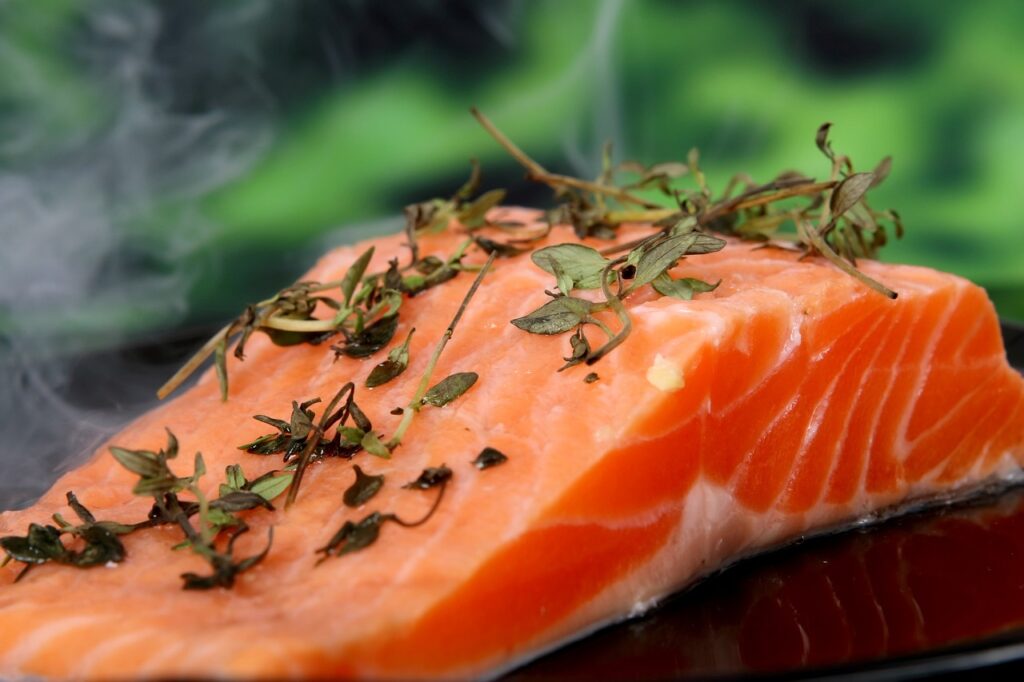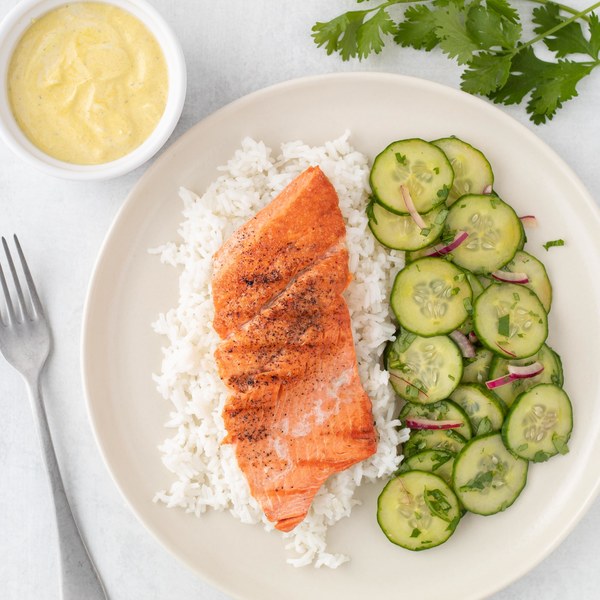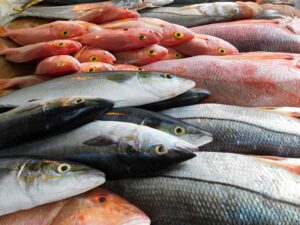Cucumber salad with fried salmon is a harmonious fusion of texture and flavor that will surely tantalize your taste buds and elevate your dining experience. Read this article to learn how to prepare and innovate this dish.
Perfect Pair: Cucumber and Salmon
Cucumber and salmon, two seemingly different ingredients, come together to create a symphony of taste and nutrition. The crispness and delicate, refreshing flavor of cucumbers contrast perfectly with the richness of salmon. This combination not only satisfies your palate but is also rich in nutrients. Cucumbers are low in calories and high in water content, while salmon is rich in heart-healthy omega-3 fatty acids and abundant in protein.
Gathering Your Ingredients
Your culinary canvas starts with cucumbers and salmon, so it’s essential to choose them wisely. When selecting cucumbers, opt for firm, blemish-free ones. Cucumbers should feel heavy, indicating they are moist and fresh. The skin should be vibrant with no wrinkles or soft spots.
When it comes to salmon, the quality of the fillets is crucial. Look for salmon that glistens due to its moisture, indicating freshness. Avoid any discolored, off-putting fishy smells, or overly bruised fillets.
While cucumbers and salmon take center stage, the other ingredients can add depth and complexity to your cucumber salad. Vibrant bell peppers bring sweetness and a burst of color. Red onions provide a spicy, slightly pungent flavor that awakens the palate. Cherry tomatoes contribute juicy, vibrant sweetness. Let’s not forget fresh herbs like dill or cilantro – their aroma elevates this dish to another level.
When gathering these ingredients, consider the season and availability. Choose ripe, seasonal vegetables for the best flavor. Remember that the quality of each ingredient contributes to the overall success of the salad.

Preparing the Salmon
First, carefully inspect the salmon fillets. Even the best fillets may occasionally have pin bones, which should be removed using kitchen tweezers or needle-nose pliers. Ensuring the salmon is bone-free will make the dining experience more enjoyable.
After checking for bones, pat the fillets dry with paper towels. This step is crucial for achieving a crispy, golden brown exterior during frying. Surface moisture on the fish can hinder the desired crispiness of the skin.
To infuse depth and complex flavors into the salmon, marination is key. Mix herbs, spices, and a little olive oil to create the marinade. The exact ingredients can be customized to your taste, but consider elements like minced garlic, fresh herbs (such as thyme or rosemary), a pinch of chili powder, a splash of lemon juice, and a touch of salt and pepper.
Here’s an example marinade recipe for salmon:
4 salmon fillets (6-8 ounces each)
3 cloves garlic, minced
2 tablespoons fresh dill, minced
2 tablespoons fresh parsley, minced
1 teaspoon chili powder
Zest of one lemon
Juice of one lemon
2 tablespoons olive oil
Salt and freshly ground black pepper, to taste
Place the salmon fillets in a shallow dish and coat them generously with the marinade. Ensure the marinade is rubbed into the flesh, ensuring even distribution of flavor. Cover the dish and let the salmon marinate for at least 20 minutes or longer at room temperature to allow the ingredients to meld together.
Marination not only imparts aroma to the salmon but also tenderizes the fish, making the dish juicier and more flavorful.
Crispy Frying Techniques
The secret to achieving a crispy, golden brown skin on the salmon lies in frying techniques. Here’s how to do it:
Preheat a skillet: Start by heating a frying pan over medium-high heat. Add a little oil, such as vegetable oil or olive oil. The oil should shimmer but not smoke.
Skin-side down: Place the salmon fillets skin-side down in the pan. This allows the skin to become beautiful and crispy. To prevent curling, gently press the fillets with a spatula for the first 20-30 seconds.
Don’t fiddle: Resist the urge to move or flip the fillets too early. Let them cook undisturbed for 3-4 minutes, depending on the thickness of the fillets. You’ll know they’re ready to flip when the edges start to become opaque.
Flip and finish: When the salmon skin becomes crispy and golden brown, carefully flip the fillets with a spatula. Continue to cook for another 3-4 minutes on the other side or until the salmon flakes easily with a fork. Be careful not to overcook, as salmon can quickly go from tender to dry.
Serve skin-side up: When plating the cucumber salad, consider placing the salmon with the skin side up to showcase the enticing crispy skin.
Making the Cucumber Salad
Creating your culinary masterpiece of cucumber salad to pair perfectly with fried salmon requires attention to detail and a keen sense of balance. Here’s how to make the cucumber salad that complements the fried salmon:
The choice of cucumber variety allows you to customize the salad to your taste preferences and experiment with different textures and flavors. English cucumbers are mild, seedless, and thin-skinned. Pickling cucumbers have a more pronounced crunch and slightly stronger flavor, adding character to your salad. Mini cucumbers, also known as Persian cucumbers, are perfect for single-serving salads.
In addition to cucumbers, you can add complementary vegetables and herbs to enhance the vibrancy and complexity of the salad.
Bell peppers: Bell peppers provide natural sweetness and vibrant colors, adding flavor and visual appeal to the salad. Red, yellow, and orange peppers are especially lively choices.
Red onions: Red onions have a spicy, slightly pungent flavor. Slicing them thinly or briefly soaking them in cold water can soften their sharpness while retaining their crispness.
Cherry Tomatoes: These bite-sized gems are filled with juicy and mild sweetness. Their vibrant color adds freshness to your salad.
Fresh Herbs: Elevate the quality of your salad with fresh herbs like dill, cilantro, or parsley. The fresh herbal aroma complements the coolness of cucumbers.
Making Oil and Vinegar Dressing or Yogurt Sauce
There are two classic salad dressings that pair well with cucumber salad with fried salmon: oil and vinegar dressing and yogurt sauce.
Oil and Vinegar Dressing:
The classic oil and vinegar dressing is a simple combination of olive oil, vinegar (or citrus juice), mustard, honey, and seasonings. Olive oil provides a rich, smooth base, while vinegar or citrus juice adds acidity. Mustard and honey bring depth and complexity, balancing richness with sweetness. Seasonings like salt, pepper, and herbs (such as oregano or basil) enhance the flavor profile.
1/4 cup extra-virgin olive oil
2 tablespoons red wine vinegar or apple cider vinegar
1 teaspoon Dijon mustard
1 clove garlic, minced (optional, for a subtle garlic flavor)
1 teaspoon honey or maple syrup (adjust to taste)
Salt and freshly ground black pepper, to taste
1/2 teaspoon dried oregano or basil (or 1 tablespoon fresh, finely chopped)
1/2 teaspoon lemon zest (optional, for added freshness)
Yogurt Sauce:
Yogurt sauce provides a creamy, rich alternative to vinegar-based dressings. Greek yogurt serves as the creamy base, providing a delightful, rich texture to your salad. Lemon juice adds a bright zing, while fresh herbs like mint or coriander impart a robust flavor. Garlic, salt, and pepper, among other seasonings, round out the overall profile.
You can customize these dressings to suit your taste by adjusting the proportions of the ingredients. For example, more honey can enhance sweetness, while extra vinegar or citrus juice can boost acidity. Don’t hesitate to experiment and find the balance that satisfies your palate.
1/2 cup Greek yogurt (full-fat or low-fat, depending on your preference)
1 tablespoon extra-virgin olive oil
1 tablespoon fresh lemon juice or vinegar
1 clove garlic, minced (for a mild garlic flavor)
2 tablespoons fresh dill, mint, or coriander, finely chopped
Salt and freshly ground black pepper, to taste
1/2 teaspoon honey or maple syrup (adjust to taste)
For a complete dining experience, pair your dish with the appropriate beverage. Crisp white wine or a light citrusy cocktail complements the flavors of the salad and salmon perfectly.

Gluten-Free Dietary Adjustments
To make your dish gluten-free, ensure that the seasonings and spices used for marinating the salmon are gluten-free. Some pre-made spice blends may contain hidden sources of gluten. If your marinade or condiments contain soy sauce, opt for gluten-free soy sauce or tamari. If you plan to add croutons or bread toppings, use gluten-free bread for baking or look for gluten-free pan-fried bread cubes.
Variations and Flavor Enhancements
One of the joys of creative cooking is the opportunity to experiment with different flavors, textures, and ingredients to create unique dishes.
Try Different Herbs and Spices
Herbs and spices are at the core and soul of any culinary creation, and they can profoundly influence the character of cucumber salad with fried salmon. Here are some suggestions for experimenting with herbs and spices:
Mediterranean Flavors: Infuse a Mediterranean flair by incorporating herbs like oregano, basil, and thyme. Consider adding a touch of sumac or za’atar for an exotic twist.
Asian Fusion: Use cilantro, mint, and Thai basil to infuse your salad with Asian flavors. Drizzle with a dressing made from soy sauce, ginger, and sesame oil for a vibrant, flavorful sensation.
Middle Eastern Charm: Add fresh parsley, mint, and a sprinkle of chopped pistachios for a Middle Eastern-inspired salad. A tahini-based dressing with lemon and garlic can bring creaminess and richness to the dish.
Southwest Spices: To achieve a Southwest flavor, season the salmon with cumin, chili powder, and paprika. Garnish with cilantro, lime, and a dash of Mexican hot sauce.
Herb Medley: Experiment with various fresh herbs such as chives, tarragon, and chervil to infuse your salad with robust herbal flavors. A simple lemon and olive oil dressing will let the herbs shine.
Explore International Flavors
Explore international flavors and ingredients without leaving your kitchen:
Greek Inspiration: Add Kalamata olives, crumbled feta cheese, and cucumber ribbons to create a Greek-inspired salad. Dress it with olive oil, lemon juice, and oregano for a perfect Mediterranean experience.
Japanese Influence: Incorporate sliced seaweed (nori), sesame seeds, and pickled ginger into your salad for a Japanese touch. A miso-based dressing with cilantro, lime, and garlic can infuse richness.
Tropical Vibes: Include pineapple chunks, mango, and shredded coconut to transport your taste buds to the tropics. A coconut-lime sauce will enhance the tropical ambiance.
Italian Elegance: Add fresh mozzarella cheese, cherry tomatoes, and basil leaves to create an Italian-inspired masterpiece. Balsamic vinegar and a touch of aged balsamic glaze will tie it all together.
Indian Influence: Marinate the salmon with curry spices to infuse Indian flavors into your salad. Garnish with cilantro, diced mango, and a yogurt-based sauce for a cool contrast.
Add Fruit or Nuts for Unique Flavors
Incorporating fruits or nuts can bring delightful contrasts in flavor, texture, and sweetness:
Berry Bliss: Add fresh berries like strawberries, raspberries, or blueberries to your salad for juicy sweetness. A vinaigrette infused with berries can perfectly complement them.
Nutty Crunch: Include roasted nuts such as almonds, walnuts, or pecans for a satisfying crunch. Nuts can also provide healthy fats and earthy richness to your salad.
Citrus Surprise: Introduce oranges, grapefruits, or blood oranges to create a citrus-centered salad. A dressing made from citrus, honey, and a touch of Dijon mustard can tie it all together.
Avocado Creaminess: Slice creamy avocado on top of your salad to impart a rich, buttery texture. Avocado-lime sauce can enhance the avocado’s creaminess.
Dried Fruit Drama: Elevate your salad with the sweetness and chewy complexity of dried fruits like apricots, cherries, or cranberries. Pair them with nuts for a delightful contrast.
Experiment with these variations and flavor enhancements to create a cucumber salad with fried salmon that suits your taste and showcases your culinary creativity. Enjoy your culinary adventures!

Conclusion
Creating the perfect cucumber salad with fried salmon is an art that combines fresh ingredients, cooking techniques, and creative talent. Whether you’re an experienced chef or a home cook looking to make a lasting impression, this dish provides endless opportunities for culinary creativity and enjoyment. So roll up your sleeves, gather your ingredients, and embark on a delicious journey.
Frequently Asked Questions
Q1: Can I use frozen salmon for this recipe?
Yes, you can use frozen salmon, but be sure to properly thaw it before marinating and cooking. When done correctly, frozen salmon can be equally delicious.
Q2: How long can I store leftover cucumber salad with fried salmon?
Leftovers can be refrigerated for up to two days, but for the best quality, it’s recommended to consume them within 24 hours. Be sure to store the salad and salmon separately to maintain their respective textures.
Q3: Can I use other types of fish instead of salmon?
Certainly! While salmon pairs perfectly with cucumbers, you can also try other fish varieties such as trout, tilapia, or cod for different flavors.
Q4: How can I make this dish spicier?
To add some spice, you can incorporate ingredients like red chili flakes, jalapeño peppers, or a touch of hot sauce into the marinade or dressing.























